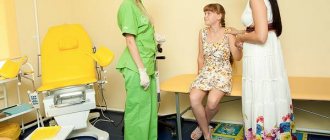Ovulation is the best period to conceive a child. It is at this time that the finished egg leaves the ovary and is ready to meet the sperm. This process does not happen every month. Women experience anovulatory cycles approximately twice a year. Signs of lack of ovulation may also indicate infertility. The main symptom is the absence of characteristic discharge. Lack of ovulation can be both pathological and physiological. The cause of the disorder can only be determined through diagnostics in a hospital setting. Normally, ovulation should occur on days 15-17 of the cycle.
When ovulation occurs, the probability of conception is greatest
How to calculate ovulation
The content of the article
In the first half of the menstrual cycle, follicles with eggs inside grow in the ovary. One of them reaches a larger size than the others and is called dominant. As a result of the release of luteinizing hormone, the follicle bursts and an egg is released. This process is called ovulation.
Normally, a woman goes through 1-2 cycles per year without maturation of the egg.
There are three ways to detect this process:
- Basal temperature;
- Ovulation tests;
- Ultrasound - folliculometry.
The last method is the most reliable, as it allows you to look inside the body and track the process of formation and release of the egg. Other methods are suitable for use at home, but their accuracy is low.
Violations may be indicated by indirect signs:
- Too little or too much discharge during menstruation;
- Male pattern hair growth – on the chin, inner thighs;
- The appearance of acne, dandruff;
- No stringy clear discharge in the middle of the cycle.
These symptoms indicate problems with hormones. If they are present, you need to visit an endocrinologist or gynecologist and get tested for female and male hormones.
Menstrual cycle
Cyclic changes in a woman’s reproductive system last from the first day of menstruation until the onset of the next menstruation. Ovulation occurs in the middle of the menstrual cycle. It represents the release of a mature germ cell from a burst follicle in the ovary and further movement into the fallopian tube through the abdominal cavity.
What happens after ovulation? If healthy sperm are present in the fallopian tubes, it means that after ovulation, fertilization is highly likely to occur.
Typically, the release of the egg occurs on days 12–14 of the menstrual cycle. But this is only possible if it is done regularly. If the cycle is irregular, or too short or long, ovulation may occur on other days.
If for some reason the egg is unable to leave the follicle, ovulation does not occur and fertilization is impossible. This situation in gynecology is called anovulation, and the cycle is anovulatory.
How to measure basal temperature
This method involves taking your temperature every day and creating a chart. A simple and free method requires a certain discipline, but it allows you to better understand your body. All you need is a mercury thermometer and a notebook or computer for keeping graphs.
Despite its simplicity, regular monitoring of temperature can reveal anovulatory cycles, hormonal problems, and inflammation. To do this, you need to record your daily temperature for 3 months. You can do the analysis yourself or bring the charts to the gynecologist.
Measurement Rules:
- During one cycle, you need to measure the temperature at the same time - optimally from 6 to 8 am;
- Measurements are taken rectally, orally or vaginally;
- Do not get out of bed before taking measurements.
2 days before the release of the egg, the temperature drops by several values, and then rises sharply and remains stably high. If, subject to all the rules, the graph remains single-phase, that is, there is no sharp increase in temperature in the second phase, then there is no ovulation.
Methods for determining fertility
To determine whether ovulation is occurring, various tests must be carried out. At home, a woman is recommended to measure her basal temperature daily.
The indicator should be measured in the morning after sleep. To obtain a reliable result, a woman should not change position or stand up. The obtained indicators are entered into the chart. Connecting the dots allows you to build a basal temperature graph.
In the constructed schedule, a sharp decrease in temperature should occur before ovulation. This phenomenon is called temperature drop. The next day ovulation occurs. With the correct course of the phases, after a favorable day the temperature rises sharply and remains at 37 degrees. If conception does not occur this month, the temperature will drop 2-3 days before your period. If a woman is pregnant, the temperature will remain high.
The absence of ovulation is detected at low temperatures. In such a graph there is no division into two phases. But not all patients can measure their temperature correctly and build a graph. In this case, it is recommended to seek help from a specialist. The doctor will use another method - folliculometry.
The essence of folliculometry is to detect a dominant neoplasm and track its growth. For this purpose, the woman must visit the clinic every two days. The first ultrasound examination should be performed the day after the end of your period. During this period, the doctor examines the condition of the endometrial layer and ovaries. A day after menstruation, tissue 5–6 mm thick should form on the inside of the uterine wall. There should be 2-3 small follicles on the surface of the ovary.
Re-inspection
During the re-examination, the doctor carefully examines the diameter of the follicular cavities. One of the neoplasms should measure 8–9 mm. The endometrium gains a thickness of 8–10 mm. From this moment on, the specialist monitors the process of growth and development of the dominant. With the correct cycle, by the end of the first phase the dominant has a diameter of 22–24 mm. This indicates his readiness to ovulate. A repeat examination is carried out after a favorable day.
During this period, the specialist examines the cavity located behind the uterus. When the dominant ruptures, fluid is released. She hits Douglas. If ovulation has occurred, there is a small amount of fluid in the Douglas. If there was no rupture, the retrouterine space will be empty.
Also, the absence of ovulation is indicated by the preservation of the dominant and its degeneration into a cystic neoplasm. In some cases, the follicle is deflated. This can be discovered when searching for the corpus luteum. If there is no fluid, the woman did not ovulate. This technique allows you to know exactly whether a woman is fertile. It is impossible to identify the problem in any other way.
Ovulation tests
Tests show a surge in luteinizing hormone, which triggers the ovulation mechanism. The test is considered positive if the test strip becomes brighter than the control line. The method is inaccurate, since a positive result may take several days. But its advantage is its low cost and the ability to perform it at home.
With a regular cycle, it is recommended to carry out tests in the middle. For example, the length of the cycle is 28 days, tests need to be done from days 12 to 16 in order to catch the moment of ovulation. For some girls it happens early or late, so tests are best combined with other methods.
Ultrasound
Folliculometry is performed several times per cycle to track the growth of the dominant follicle, its rupture and the formation of the corpus luteum. You need to do an ultrasound for the first time on days 8-10 of the cycle, before ovulation begins. At this time, the dominant follicle should grow to 1.5 cm. When it grows to 2.5 cm, it will burst. After ovulation, the doctor should see the corpus luteum and fluid in the back of the uterine space.
This method allows you to find out the exact day of follicle rupture and identify abnormalities. You can talk about diseases of the ovaries or thyroid gland only if an ultrasound scan has confirmed the absence of ovulation for 3 cycles in a row.
Reasons for lack of ovulation
Failures in ovulation can be observed in adolescents when the menstrual cycle has not yet established, and in women before the approach of menopause, when the body’s supply of eggs has been depleted. During pregnancy, after childbirth and during breastfeeding, this process is blocked by hormones.
Some diseases of the hormonal and reproductive system can affect ovulation. It does not occur at all or the egg does not mature in the follicle. If this repeats for 3 cycles in a row, this is a reason to consult a doctor.
Reasons for lack of ovulation during regular menstruation:
- Polycystic ovary syndrome;
- Hormonal disorders;
- Thyroid diseases;
- Disruption of the pituitary gland;
- Infections;
- Inflammation in the pelvic area;
- Obesity or anorexia;
- Stress, physical exhaustion or fatigue.
It is important for girls to monitor their emotional state, since stress and negative emotions directly affect reproductive health. Do not lift heavy objects or expose yourself to excessive physical exertion.
Following a daily routine and proper nutrition will protect you from most diseases of the reproductive system.
Why is there no ovulation during regular periods and how can you stimulate it?
- 1 Causes of anovulation
- 2 The mechanism of pathology development
- 3 Signs
- 4 Diagnostics
- 5 Treatment methods
- 6 Medicines and folk remedies
- 7 Stimulation of ovulation
- General concepts about the menstrual cycle and its stages
- Is ovulation possible without menstruation?
- In what cases does ovulation occur without menstruation?
- Is it possible to conceive if you don't have periods?
- How to determine whether ovulation has occurred
- Prevention
- Can you have periods without ovulation?
- Characteristics of female fertility
- Methods for determining fertility
- Re-inspection
- Additional factors
- Diagnosis before starting therapy
- Pills to restore ovulation
- Injections to restore ovulation
- Drugs to reduce prolactin levels in the blood
- Laparoscopy
- ECO
- The main symptoms of lack of ovulation
- How is basal temperature measured?
- Basal temperature chart
- Diagnosis of ovulatory dysfunction
- 1. Taking an anamnesis.
- Lack of ovulation - a death sentence or a problem that can be solved
- How to restore ovulation - proven methods
- The menstrual cycle and its features
- It is known that for the birth of a new life, the participation of two cells is necessary: a sperm and an egg, which matures every month in a woman’s ovary. But it happens that this process is disrupted and ovulation does not occur, which means conception is impossible. But this often becomes the main cause of infertility... Why does this happen and how to return the “lost” egg?
- Diseases leading to anovulation
- Can menstruation occur without the release of an egg from the follicle?
- Why is there no ovulatory phase during regular menstrual cycles?
Anovulation is a consequence of a pathological process in the body. If there is no ovulation, you should find out the possible reasons. As practice shows, even in healthy women, this problem can be detected by all indicators, but this percentage is small.
Reasons for lack of ovulation during regular menstruation:
This reason most often applies to girls during menarche - the first menstrual bleeding; it can also be observed in women during menopause or in young mothers during lactation. In medical practice, there are cases of anovulation of unknown origin. Most often, this phenomenon is associated with a sudden change of place of residence or a tourist trip.
The hypothalamic-pituitary system is responsible for the regulation of hormones in the body. When this system fails, disturbances in the functioning of the thyroid gland and, as a consequence, dysfunction of the ovaries occur. This leads to a lack of the hormone that stimulates the follicles to full maturation, which leads to a lack of ovulation and, as a consequence, the inability to get pregnant.
Also, high prolactin and lactotropic hormone can interfere with egg maturation.
Genetic disorders associated with abnormal development of the uterus and ovaries are diagnosed at birth, but a general delay in puberty appears as the girl grows older, and the pathology may not be recognized until physical maturity.
- 4. Other reasons why ovulation does not occur:
- low body mass index due to anorexia or bulimia;
- compulsive overeating and, as a result, obesity;
- inflammatory pathologies of the pelvic organs, often chronic;
- sexually transmitted diseases;
- some gynecological diseases, such as endometriosis;
- pathologies of the thyroid gland and adrenal glands;
- hormonal disorder;
- excess male hormones in the female body;
- lactation period;
- stress;
- excessive exercise;
- poisoning with toxic substances;
- decrease in the hormone estrogen.
In most cases, women are not aware of disruptions in the menstrual cycle, relying on regular periods.
We recommend What is an anovulatory cycle, why does it happen and how to stimulate ovulation?
2 The mechanism of pathology development
The maturation of the egg occurs in the follicle, which, in turn, goes through certain stages of growth (folliculogenesis). The growth of the follicle ends with ovulation in the 14th week, reaching 2.4 cm in diameter. At this stage you can become pregnant, so it is the main process that ensures the body is ready for conception.
Why is there no ovulation?
- impaired growth and development of the follicle (steroidal female sex hormones (estrogens) increase significantly and sharply);
- the follicle undergoes a reverse development process (estrogens increase very slowly).
- the hormone progesterone is not produced because the corpus luteum is not formed.
Menstruation during anovulation is actually absent; it is mistaken for similar bleeding, which appears when the follicle decreases in diameter.
The first periods in girls may not be accompanied by ovulation, because the production of female sex hormones during this period is just getting better. The mechanism for menopause is based on the same principle, only in reverse.
We recommend Why do breasts hurt after ovulation, and is this normal?
3 Signs
Anovulation can be a consequence of a serious pathology, for example, an ovarian tumor, so it is worth knowing all the accompanying signs:
- inability to become pregnant for more than six months;
- failure of menstrual flow;
- pain in the chest;
- polycystic ovary syndrome;
- acne;
- causeless hair loss;
- cardiovascular diseases;
- increased blood sugar;
- excess hair growth on the body and face;
- profuse bleeding.
Bleeding during anovulation is the same as during menstruation, so they are always confused, and it is impossible to recognize the pathology (with the exception of bleeding that occurs when the hormone estrogen increases, or scanty discharge when this hormone decreases).
We recommend Why does breast pain occur after ovulation? Advice and recommendations from experts
4 Diagnostics
There are various causes of infertility, therefore, in order to identify the true cause, you should undergo a number of procedures:
- 1. Analysis of venous blood to determine the concentration of hormones.
It is necessary to check hormones not just once, but several times, thus eliminating the possibility of errors in the laboratory test results. You should also know that hormonal levels can change monthly, and therefore, after the initial test, the doctor will not be able to draw a conclusion about ovulation (a permanent or one-time failure in a woman’s body).
- 2. Blood test to exclude endocrine pathologies.
This analysis is considered basic, since in no case should you start stimulating the ovaries if a pathology of the thyroid gland is detected, otherwise the hormones of the endocrine system may interfere with the release of the egg. There are often cases when, after treatment of thyroid diseases, the problem with conception goes away along with the elimination of the pathology.
- 3. Functional hormonal tests.
- 4. Ultrasound examination of the reproductive system.
The study is carried out on the 8th – 10th day after the end of menstruation. Then every 2 or 3 days, at best until the start of ovulation, at worst until the start of menstruation. The doctor can make the following pathogenetic conclusion about why ovulation does not occur:
- the ovaries are in a state of “sleep”, the follicles do not go through stages of development;
- the follicle begins its development, but at a certain stage begins to decrease in size (follicular atresia);
- the detected dominant follicle in the ovary develops, but, without reaching maturity, forms a corpus luteum without the release of an egg (without rupture of the follicle);
- the detected dominant follicle develops to a normal size, but it does not rupture, forming a cyst, or the follicle decreases in size (in this case, an injection of hCG, human chorionic gonadotropin, is prescribed for treatment).
5 Treatment methods
If there is no ovulation, then pregnancy is impossible. This means that the problem is medical in nature and, therefore, should be dealt with by doctors.
What to do if there is no ovulation?
- consult a doctor;
- undergo a series of studies to identify the cause;
- eliminate the cause;
- undergo a course of drug stimulation of the ovaries (provided that the cause is not found or its elimination does not produce the desired result).
Treatment for ovulation directly depends on the cause. The conservative treatment method is based on adjusting the balance of hormones. If the cause of anovulation is established, it should be eliminated.
For example, in case of obesity, the patient should concentrate all his efforts on weight loss; as a rule, it is enough for a woman to lose a tenth of her total body weight.
If an infectious disease is detected that presumably or definitely interferes with the ovulation process, the doctor also prescribes treatment aimed at eliminating it.
If the treatment does not give the desired result, then they proceed to stimulation, having first gone through all the stages of diagnosis.
6 Medicines and folk remedies
Modern medicine has come so far that ovulation can be induced with special medications. They are conventionally divided into three types:
- Inducers of follicle growth and development. Sometimes they are combined with birth control pills.
- Ovulation triggers affecting luteinizing hormone. This drug leads to ovulation in less than two days.
- Medicines to support the functioning of the corpus luteum.
The doctor selects the scheme for stimulating the ovaries for ovulation individually for each patient, depending on:
- the result of assessing the functional reserve of the ovaries (egg reserve);
- body mass index;
- evaluation of stimulation schemes already carried out (if any).
Most often, hormonal drugs are combined in regimens.
Unfortunately, this treatment method does not provide a 100% guarantee of pregnancy. The positive result after the first stimulation averages 13%.
Traditional methods of combating anovulation include taking herbal tinctures according to the following scheme:
- taking sage infusion during the follicular phase of the cycle;
- taking an infusion of boron uterus during the luteal phase of the cycle.
7 Stimulation of ovulation
The stimulation process throughout all stages is carried out under the supervision of the attending physician, since constant monitoring of the condition of the ovaries is necessary, and there are also certain risks.
Stages of a long protocol:
- Blockage of the pituitary gland. It can last from 10 to 20 days, depending on the individual characteristics of the body.
- Stimulation of the ovaries by hormones of the pituitary gland and placenta. The duration of the stage is about two weeks.
- Stimulating injection two days after completion of the gonadotropic drug.
- Supporting the functioning of the corpus luteum with synthetic gestagens.
The stages of the short stimulation protocol fit within the framework of one monthly cycle, its duration is 17 days. The beginning of the process also begins with a blockade of the pituitary gland, followed by stimulation with gonadotropins. The most popular gonadotropin today is a drug with antagonists, since it eliminates spontaneous ovulation.
Side effects during the stimulation process:
- cramping pain in the lower back and lower abdomen;
- sweating;
- lack of sleep;
- headache;
- flatulence;
- restless state.
General concepts about the menstrual cycle and its stages
Menstruation is actually the beginning of the menstrual cycle, which in turn is a monthly repeating cycle of preparing the female reproductive system for childbearing.
Its duration is conventionally taken to be a month, although it can vary between 21-35 days. The menstrual cycle consists of several phases.
Source: //yazdorov.win/ginekologiya/pochemu-net-ovulyatsii-pri-regulyarnyh-mesyachnyh-i-kak-mozhno-ee-stimulirovat.html
PCOS
Polycystic ovary syndrome is a complex of disorders in the body, which is characterized not only by gynecological symptoms, but also affects other organs. During the process of formation, the ovaries change their structure, which is why the girl’s entire menstrual cycle is disrupted. Most women with this syndrome are diagnosed with infertility.
The activity of the ovaries depends on the pituitary gland. It produces hormones that trigger the process of maturation and release of the egg. The ovaries themselves also produce hormones - estrogen and progesterone, which affect all organs. A woman with hormonal system disorders has the following abnormalities:
- Obesity;
- Male pattern hair growth;
- Irritability, insomnia, sudden mood swings;
- Lack of vaginal lubrication.
The main symptom of PCOS is rare, scanty menstruation, and an unstable cycle. This is a reason to contact a gynecologist. The sooner the girl comes to the doctor, the more successful the treatment will be. The diagnosis is made after a blood test and pelvic ultrasound.
Treatment of PCOS involves a complex effect on the endocrine system. First of all, doctors recommend bringing your weight back to normal and getting rid of obesity. Patients are prescribed vitamins and hormonal contraceptives that regulate hormone levels in the body. This allows you to restore a two-phase regular cycle and induce ovulation.
Why there is no ovulation with regular periods
The term ovulation comes from the Latin word meaning “testicle.” It describes the process when a female gamete, mature and ready for fertilization, leaves the follicle. The work of this system is regulated by hormonal levels, which are stable in a healthy woman.
The process of gamete maturation begins immediately after the completion of menstrual bleeding. The production of estrogen stimulates the growth of several follicles, among which one (more rarely, two or more) stands out by the middle of the cycle.
When the so-called sac containing the egg is ready to open, the pituitary gland produces luteinizing hormone. Thanks to him, the gamete enters the abdominal cavity, and then descends through the fallopian tubes. On its way, the egg meets the male sperm, resulting in fertilization.
If fusion does not occur, but after 10-14 days a new cycle begins with the next menstruation.
If you don't ovulate, you won't be able to get pregnant. This hypothesis was confirmed many years ago. However, modern techniques of assisted reproductive technologies have made the impossible possible. It is possible to get pregnant if there is no ovulation, but you will have to subject your body to hormonal, drug or surgical correction, and if there is no result, use donor material.
Symptoms and diagnosis of anovulation
The absence of ovulation may not manifest itself in any way for a long time. Until a woman wants to get pregnant, nothing will bother her. With the same success, a representative of the fairer sex can acutely feel the signs of lack of ovulation, which are expressed in:
- irregularity of the menstrual cycle (with the exception of physiological causes of anovulation);
- rare and scanty periods, which become smaller each time and disappear (this happens with chronic long-term anovulation);
- uterine bleeding (caused by excessive growth of the endometrium over a long period and the sudden onset of menstruation);
- external changes (with polycystic ovary syndrome, there is an increase in body weight, excessive hair growth and the appearance of acne);
- painful sensations in the mammary glands (with increased prolactin).
For women, the most important sign that it is necessary to see a gynecologist is the absence of pregnancy. This symptom is one of the first on the basis of which anovulation is diagnosed.
Symptoms of lack of ovulation are immediately noticed by the gynecologist. When visiting a doctor, the patient talks about her complaints. Based on the initial consultation, the doctor cannot make an accurate diagnosis and say with confidence that ovulation is not occurring. To establish this fact, it is necessary to conduct an examination.
The first and most accessible diagnostic procedure is ultrasound. The study shows the condition of the gonads (presence of tumors, cysts, distorted size, absence of a dominant follicle). It is acceptable to classify the detected pathologies as one cycle. If the picture repeats itself next month, then there is no doubt: there is no ovulation.
The second step in diagnosis is a hormone analysis. On certain days of the menstrual cycle, a woman is prescribed to donate blood to determine the levels of FSH, LH, progesterone and estradiol. If sex hormones are normal, then TSH, testosterone, and prolactin are additionally examined.
An easy and reliable way to diagnose anovulation is to measure basal temperature. Manipulation is carried out using the rectal method daily, immediately after waking up. The indicators are entered into a table that builds a curve.
Normally, it has low values in the first phase of the cycle and high values in the second. Between these periods there is a drop (one-day decrease) in values, indicating maximum LH production.
The graph of basal temperature in the absence of ovulation is uneven, with the presence of spikes and decreases in indicators.
Every representative of the fairer sex should know what anovulation is and how to understand that the egg does not leave the ovary. Irregular periods are a reason to contact a gynecologist and undergo a diagnosis.
Treatment of anovulation
On women's forums you can find references to stimulating ovulation with hormonal drugs. Most often, this procedure is performed during IVF to mature as many eggs as possible.
Stimulation has many side effects, the main one being premature ovarian failure. Therefore, it is not recommended to do it more than 5 times in your entire life.
The most effective way to restore ovulation is to treat diseases that block this mechanism. To identify them, you should take tests:
- Blood for female hormones;
- Blood for sexually transmitted diseases;
- Pap smear for STDs;
- Ultrasound of the pelvic organs.
If pathological formations in the uterus are suspected, hysteroscopy is prescribed. During the procedure, a video camera and probe are inserted into the uterine cavity. Doctors examine the mucous membrane and make a diagnosis. Polyps, fibroids, endometriosis are diseases that lead to anovulation and infertility. They can be cured with surgery.
Treatment of anovulation involves a healthy lifestyle and taking vitamins. Proper nutrition and the absence of bad habits will help the body restore natural functions and establish the ovulation mechanism.
ONLINE REGISTRATION at the DIANA clinic
You can sign up by calling the toll-free phone number 8-800-707-15-60 or filling out the contact form. In this case, we will contact you ourselves.
If you find an error, please select a piece of text and press Ctrl+Enter











